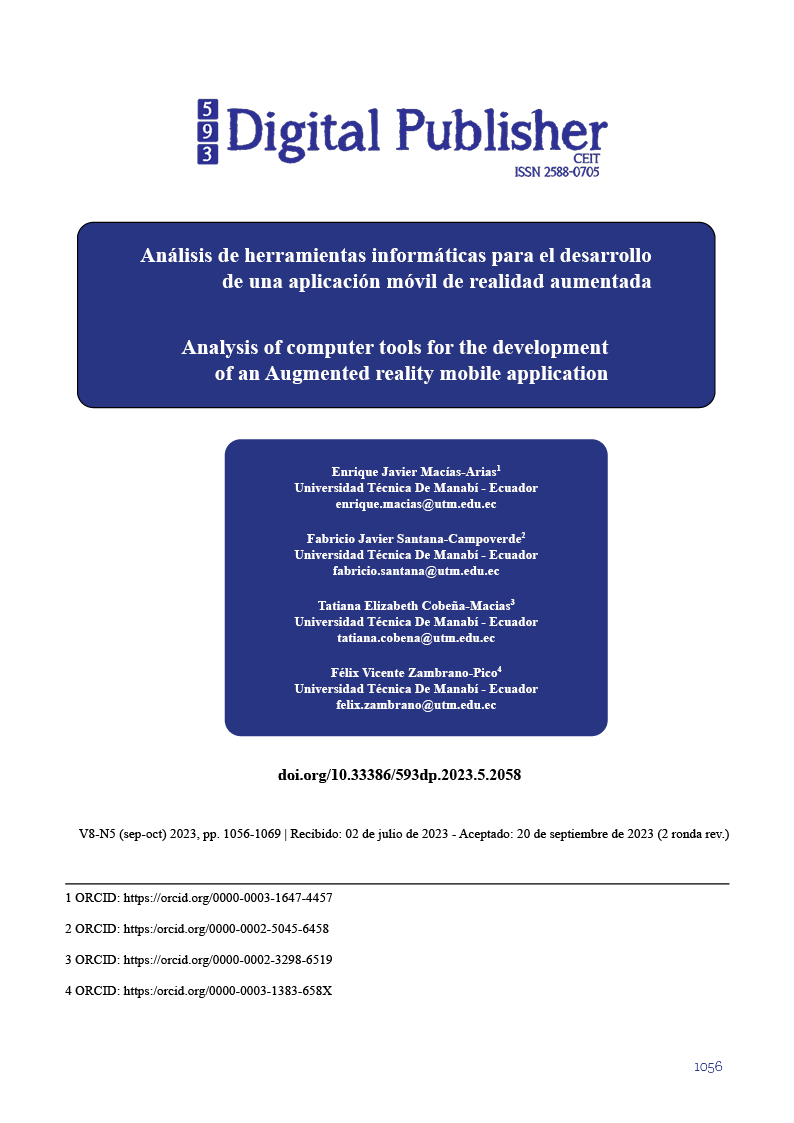Analysis of computer tools for the development of an Augmented reality mobile application
Main Article Content
Abstract
This research addresses the evaluation of computer tools available for the effective development of augmented reality (AR) mobile applications. The main objective is to identify the most suitable platforms and technologies that optimize the AR application creation process, considering key factors such as usability, performance and accessibility. The research is framed in an exploratory and descriptive study, using a mixed approach that combines quantitative and qualitative analysis. The aim is to obtain a deep understanding of the available tools and their applicability in the context of developing augmented reality mobile applications. A comprehensive literature review is carried out to identify relevant IT tools. Benchmarking techniques are used to evaluate the effectiveness of each tool in terms of AR application development. The techniques include a comparative analysis based on augmented reality tools. In addition, the Likert scale is used, which is a tool widely used in research of various kinds that serves as the basis for this study. The research contributes to practical knowledge by offering specific recommendations based on the empirical evidence collected. As a result of the research, EasyAR Sense stands out as the best tool for building augmented reality applications, supported by Creator AVR and Blippar as equally solid options. This analysis provides valuable guidance for developers when selecting tools for AR application development, considering key factors such as image recognition, API integration, and licensing. In conclusion, the choice of tool for the development of augmented reality mobile applications should be based on a careful weighing of the project requirements, prioritizing performance, usability and flexibility. Although each tool has its advantages and disadvantages, the knowledge gained through this analysis facilitates more informed decision making. The need for continuous evaluation is highlighted as technologies evolve and new tools are introduced to the market. This study provides a solid foundation for future research and development in the dynamic field of mobile augmented reality.
Downloads
Article Details

This work is licensed under a Creative Commons Attribution-NonCommercial-ShareAlike 4.0 International License.
1. Derechos de autor
Las obras que se publican en 593 Digital Publisher CEIT están sujetas a los siguientes términos:
1.1. 593 Digital Publisher CEIT, conserva los derechos patrimoniales (copyright) de las obras publicadas, favorece y permite la reutilización de las mismas bajo la licencia Licencia Creative Commons 4.0 de Reconocimiento-NoComercial-CompartirIgual 4.0, por lo cual se pueden copiar, usar, difundir, transmitir y exponer públicamente, siempre que:
1.1.a. Se cite la autoría y fuente original de su publicación (revista, editorial, URL).
1.1.b. No se usen para fines comerciales u onerosos.
1.1.c. Se mencione la existencia y especificaciones de esta licencia de uso.
References
Cabero Almenar, J., De La Horra Villacé, I., & Sánchez Bolado, J. (2018). La realidad aumentada como herramienta educativa. Ediciones Paraninfo, S.A.
Caiza, Á. (2016). Estudio comparativo de herramientas de desarrollo para software de realidad aumentada orientado a la implementación de una aplicación móvil informativa publicitaria de la PUCESA [Universidad Católica del Ecuador]. https://repositorio.pucesa.edu.ec/bitstream/123456789/1630/1/76152.pdf
Carrión, G. (2018). Comparativa de tres herramientas de realidad aumentada utilizando una metodología de medición de software ISO 25010 [Universidad Técnica del Norte]. https://core.ac.uk/download/pdf/200327713.pdf
Castillo, J. O. (2017). La realidad virtual y la realidad aumentada en el proceso de marketing. 3(24), 155-299. https://ojs.ehu.eus/index.php/rdae/article/view/19141/17114
Ferrada, H. (2014). Estudio de Herramientas de Realidad Aumentada Sobre Plataforma Android [Universidad del Bío-Bío]. http://repobib.ubiobio.cl/jspui/bitstream/123456789/610/1/Ferrada%20Valeria%2C%20Hector%20Piero.pdf
Gesa, R. F. (2012). Combinando la realidad aumentada con las plataformas de e-elearning adaptativas. 9(2), 69-78. https://dialnet.unirioja.es/descarga/articulo/3971545.pdf
González Morcillo, C., Vallejo Fernández, D., Alonso Albursac, J., & Castro Sánchez, J. (2016). Realidad Aumentada. Un enfoque práctico con ARToolKit y Blender (1.a ed.). Bubok Publishig S.L. https://www.librorealidadaumentada.com/descargas/Realidad_Aumentada_1a_Edicion.pdf
Guzmán Paredes, Y. (2022). Realidad aumentada utilizando Unity. Ediciones Universidad Cooperativa de Colombia. https://doi.org/10.16925/gcgp.64
Heras, L., & Villareal, J. (2016). La realidad aumentada: una tecnología en espera de usuarios. 5(7), 1-9. https://www.revista.unam.mx/vol.8/num6/art48/jun_art48.pdf
Hernández, G. M., Cao, N. N., Ledo, M. V., & María, L. (2016). Los entornos personales de aprendizaje en los procesos de formación formales e informales. 30(3), 599-608. https://www.medigraphic.com/pdfs/educacion/cem-2016/cem163m.pdf
Herrera, S. I., Fennema, M. C., Morales, M. I., Maldonado, M., Palavecino, R. A., Rosenzvaig, F., Macedo, A., Suárez, C., Pellicer, R., & Villavicencio, R. (2019). Sistemas móviles multiplataforma con realidad aumentada. Aplicaciones en educación y salud. XXI Workshop de Investigadores en Ciencias de la Computación, San Juan. http://sedici.unlp.edu.ar/handle/10915/77150
Hurtado, E. (2019). Aplicación de realidad aumentada para el mantenimiento y reparación de computadoras personales en el departamento de telemática de “UNIANDES” [UNIANDES]. https://dspace.uniandes.edu.ec/bitstream/123456789/10819/1/PIUASIS012-2019.pdf
Jiménez, J. M., Martínez, S. M., & Acuña, B. P. (2019). La realidad audiovisual como nuevo vehículo de comunicación. Editorial GEDISA.
Ledo, M. J. V., & Oliva, B. F. (2015). Aprender, desaprender, reaprender. 29(2), 441-422. http://scielo.sld.cu/pdf/ems/v29n2/ems19215.pdf
Marín, M. C. P. (2018). La realidad aumentada en la comunicación literaria. el caso de los libros interactivos. 29(2), 1-16. https://dialnet.unirioja.es/descarga/articulo/4911683.pdf
Márquez Domínguez, J. A. (2018). Juegos didácticos y la realidad aumentada, un análisis para el aprendizaje en estudiantes de nivel básico. RIDE. Revista Iberoamericana para la Investigación y el Desarrollo Educativo, 9(17), 448-461. https://doi.org/10.23913/ride.v9i17.388
Olvera, W., Gámez, I., & Martínez-Castillo, J. (2014). Aula Invertida o Modelo Invertido de Aprendizaje: Origen, sustento e implicaciones (pp. 143-160).
Salazar, F. A. S., Pineda, C. A. P., Arciniega, S. R. A., & Cervantes, N. N. C. (2018). Comparativa técnica de herramientas para realidad aumentada: Wikitude, vuforia y artoolkit. AXIOMA, 19, Article 19. http://axioma.pucesi.edu.ec/index.php/axioma/article/view/545
Salazar Mesía, N. A. (2019). Análisis comparativo de librerías de realidad aumentada [Tesis, Universidad Nacional de La Plata]. http://sedici.unlp.edu.ar/handle/10915/76545
Serrano, A. (2012). Herramientas de desarrollo libres para aplicaciones de Realidad Aumentada con Android. [Universidad Politécnica de Valencia]. https://riunet.upv.es/bitstream/handle/10251/18028/Memoria%20TFM%20Ana%20Serrano.pdf
SIles, P. (2023). Producción de efectos visuales 3D a partir de sistemas de partículas y fluidos. Ingeniería del agua, 18(1), ix. https://doi.org/10.4995/ia.2014.3293
Valera Bautista, J. (2022). Desarrollo del juego del parchís en realidad aumentada para móviles con AR Foundation de Unity3D [Universidad de Madrid]. https://oa.upm.es/cgi/export/70546/
Vera, S. (2022). Animación experimental 3D por nodos. [Universidad de Granada]. https://digibug.ugr.es/bitstream/handle/10481/77163/TFM%20Vera%20Idoate%2c%20Sergio_comp.pdf?sequence=4&isAllowed=y





